Contactless Measurements of Carrier Concentrations in InGaAs Layers for Utilizing in InP-Based Quantum Cascade Lasers by Employing Optical Spectroscopy
Abstract
1. Introduction
2. Materials and Methods
3. Results
4. Discussion
5. Conclusions
Author Contributions
Funding
Acknowledgments
Conflicts of Interest
References
- Schiff, H.I.; Mackay, G.I.; Bechara, J. Air Monitoring by Spectroscopy Techniques; Wiley: New York, NY, USA, 1994. [Google Scholar]
- Wang, C.; Sahay, P. Breath Analysis Using Laser Spectroscopic Techniques: Breath Biomarkers, Spectral Fingerprints, and Detection Limits. Sensors 2009, 9, 8230–8262. [Google Scholar] [CrossRef] [PubMed]
- Airoptic. Available online: https://www.airoptic.pl (accessed on 30 January 2020).
- Nanoplus GmbH. Available online: https://nanoplus.com (accessed on 30 January 2020).
- Kosterev, A.; Wysocki, G.; Bakhirkin, Y.; So, S.; Lewicki, R.; Fraser, M.; Tittel, F.; Curl, R.F. Application of quantum cascade lasers to trace gas analysis. Appl. Phys. B 2008, 90, 165–176. [Google Scholar] [CrossRef]
- Nikodem, M.; Gomółka, G.; Klimczak, M.; Pysz, D.; Buczyński, R. Demonstration of mid-infrared gas sensing using an anti-resonant hollow core fiber and a quantum cascade laser. Opt. Express 2019, 27, 36350–36357. [Google Scholar] [CrossRef] [PubMed]
- Kluczyński, P.; Lundqvist, S.; Westberg, J.; Axner, O. Faraday rotation spectrometer with sub-second response time for detection of nitric oxide using a cw DFB quantum cascade laser at 5.33 um. Appl. Phys. B 2011, 103, 451–459. [Google Scholar] [CrossRef]
- Lu, Q.Y.; Manna, S.; Wu, D.H.; Slivken, S.; Razeghi, M. Shortwave quantum cascade laser frequency comb for multi-heterodynespectroscopy. Appl. Phys. Lett. 2018, 112, 141104. [Google Scholar] [CrossRef]
- Lundqvist, S.; Kluczynski, P.; Weih, R.; von Edlinger, M.; Naehle, L.; Fischer, M.; Bauer, A.; Hoefling, S.; Koeth, J. Sensing of formaldehyde using a distributed feedback interband cascade laser emitting around 3493 nm. Appl. Opt. 2012, 51, 6009–6013. [Google Scholar] [CrossRef]
- Tutuncu, E.; Nageke, M.; Becker, S.; Fischer, M.; Koeth, J.; Wolf, C.; Kostler, S.; Ribitsch, V.; Teuber, A.; Groeger, M.; et al. Advanced Photonic Sensors Based on Interband Cascade lasers for Real-Time Mouse Breath Analysis. ACS Sens. 2018, 3, 1743–1749. [Google Scholar] [CrossRef]
- Tomokage, H.; Yanahira, T.; Yoshida, M. On the Basic Assumption to Obtain Carrier Concentration Profile by Differential Hall Coefficient Measurement. Jpn. J. Appl. Phys. 1996, 35, 1824–1825. [Google Scholar] [CrossRef]
- Berreman, D.W. Infrared absorption at longitunal optic frequency in cubic crystal films. Phys. Rev. 1966, 130, 2193–2198. [Google Scholar] [CrossRef]
- Harbecke, B.; Heinz, B.; Grosse, P. Optical Properties of Thin Films and the Berreman Effect. Appl. Phys. A 1985, 38, 263–267. [Google Scholar] [CrossRef]
- Shaykhutdinov, T.; Furchner, A.; Rappich, J.; Hinrichs, K. Mid-infrared nanospectroscopy of Berreman mode and epsilon-near-zero local field confinement in thin films. Opt. Mater. Express 2017, 7, 3706–3714. [Google Scholar] [CrossRef]
- Calvani, P.; Kalaboukhov, A.; Shibayev, P.P.; Salehi, M.; Moon, J.; Oh, S.; Falsetti, E.; Ortolani, M.; Granozio, F.M.; Brubach, J.-B.; et al. Infrared spectroscopy of two-dimensional systems. Eur. Phys. J. Special Topics 2019, 228, 669–673. [Google Scholar] [CrossRef]
- Ibáñez, J.; Tarhan, E.; Ramdas, A.K.; Hernández, S.; Cuscó, R.; Artús, L.; Melloch, M.R.; Hopkinson, M. Direct observation of LO phonon-plasmon coupled modes in the infrared transmission spectra of n-GaAs and n-InxGa1−xAs epilayers. Phys. Rev. B 2004, 69, 075314. [Google Scholar] [CrossRef]
- Motyka, M.; Misiewicz, J. Fast Differential Reflectance Spectroscopy of Semiconductor Structures for Infrared Applications by Using Fourier Transform Spectrometer. Appl. Phys. Express 2010, 3, 112401. [Google Scholar] [CrossRef]
- Motyka, M.; Sek, G.; Janiak, F.; Misiewicz, J.; Klos, K.; Piotrowski, J. Fourier-transformed photoreflectance and fast differential reflectance of HgCdTe layers. The issues of spectral resoultion and Fabry-Perot oscillations. Meas. Sci. Technol. 2011, 22, 125601. [Google Scholar] [CrossRef]
- Motyka, M.; Sęk, G.; Misiewicz, J.; Bauer, A.; Dallner, M.; Höfling, S.; Forchel, A. Fourier Transformed Photoreflectance and Photoluminescence of Mid infrared GaSb-Based Type II Quantum Wells. Appl. Phys. Express 2009, 2, 126505. [Google Scholar] [CrossRef]
- Dyksik, M.; Motyka, M.; Kurka, M.; Ryczko, K.; Schade, A.; Kamp, M.; Höfling, S.; Sęk, G. Electrical Tuning of the oscillator strength in type II InAs/GaInSb quantum wells for active regions of passively mode-locked interband cascade lasers. Jpn. J. Appl. Phys 2017, 56, 110301. [Google Scholar] [CrossRef]
- Gutowski, P.; Sankowska, I.; Karbownik, P.; Pierscinska, D.; Serebrennikova, O.; Morawiec, M.; Pruszynska-Karbownik, E.; Golaszewska-Malec, K.; Pierscinski, K.; Muszalski, J.; et al. MBE growth of strain-compensated InGaAs/InAlAs/InP quantum cascade lasers. J. Cryst. Growth 2017, 466, 22–29. [Google Scholar] [CrossRef]
- Charache, G.; DePoy, D.; Raynolds, J.; Baldasaro, P.; Miyano, K.; Holden, T.; Pollak, F.; Sharps, P.; Timmons, M.; Geller, C.; et al. Moss-Burstein and plasma reflection characteristics of heavily doped n-type InxGa1-xAs and InPyAs1-y. J. Appl. Phys. 1999, 86, 242452. [Google Scholar] [CrossRef]
- Kozub, M.; Motyka, M.; Dyksik, M.; Sek, G.; Misiewicz, J.; Nishisaka, K.; Maemoto, T.; Sasa, S. Non-destructive carrier concentration determination in InAs thin films for THz radiation generating devices using fast differential reflectance spectroscopy. Opt. Quant. Electron. 2016, 48, 384. [Google Scholar] [CrossRef][Green Version]
- Hinkey, R.; Tian, Z.; Yang, R.; Mishima, T.; Santos, M. Reflectance spectrum of plasmon waveguide interband cascade lasers and observation of the Berreman effect. J. Appl. Phys. 2011, 110, 043113. [Google Scholar] [CrossRef]
- Dyksik, M.; Motyka, M.; Sek, G.; Misiewicz, J.; Dallner, M.; Höfling, S.; Kamp, M. Influence of carrier concentration on properties of InAs waveguide layers in interband cascade laser structures. J. Appl. Phys. 2016, 120, 043104. [Google Scholar] [CrossRef]
- Li, Y.; Stradling, R.; Knight, T.; Birch, J.; Thomas, R.; Phillips, C.; Ferguson, I. Infrared reflection and transmission of undoped and Si-doped InAs grown on GaAs by molecular beam epitaxy. Semicond. Sci. Technol. 1993, 8, 101. [Google Scholar] [CrossRef]
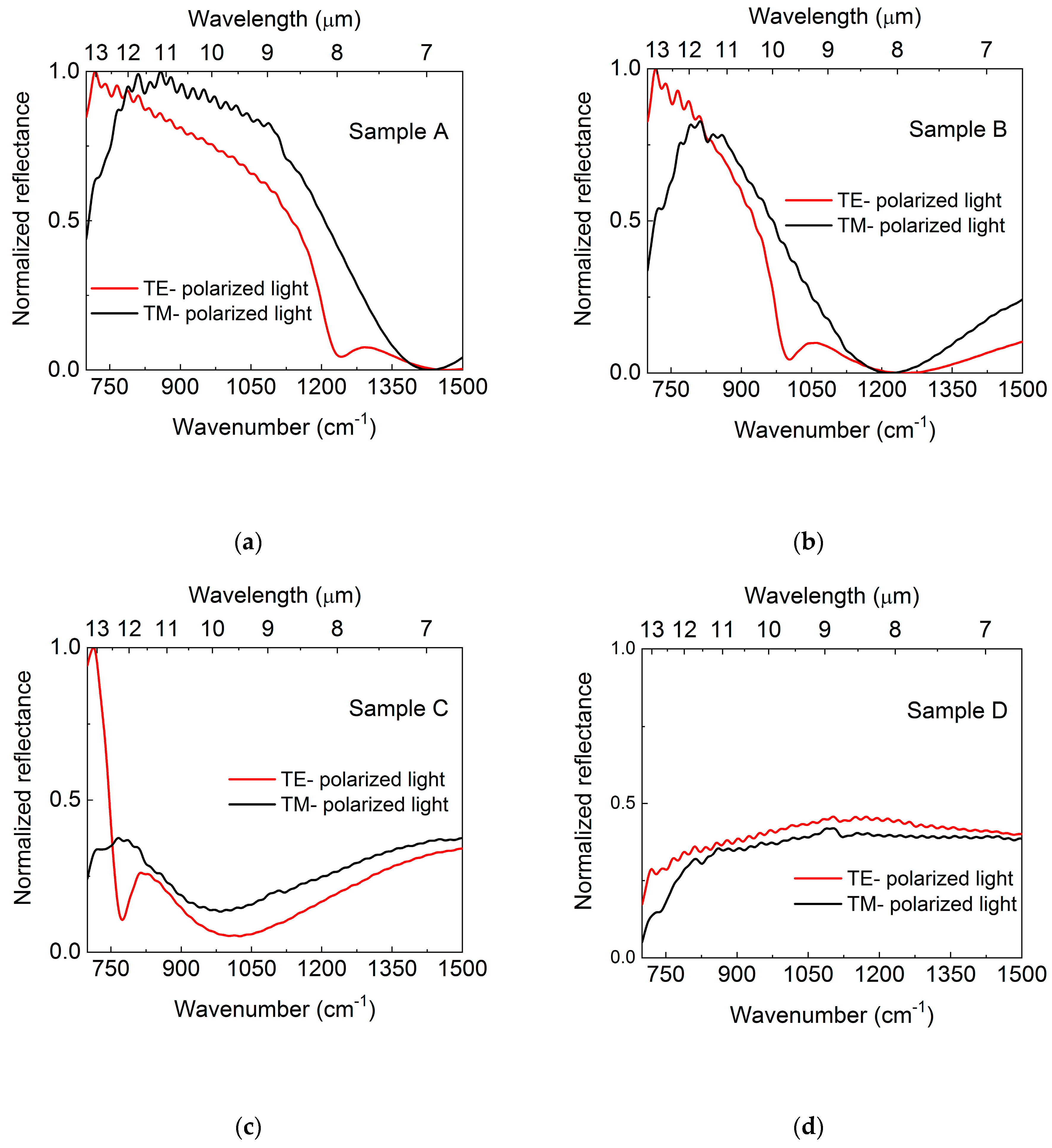
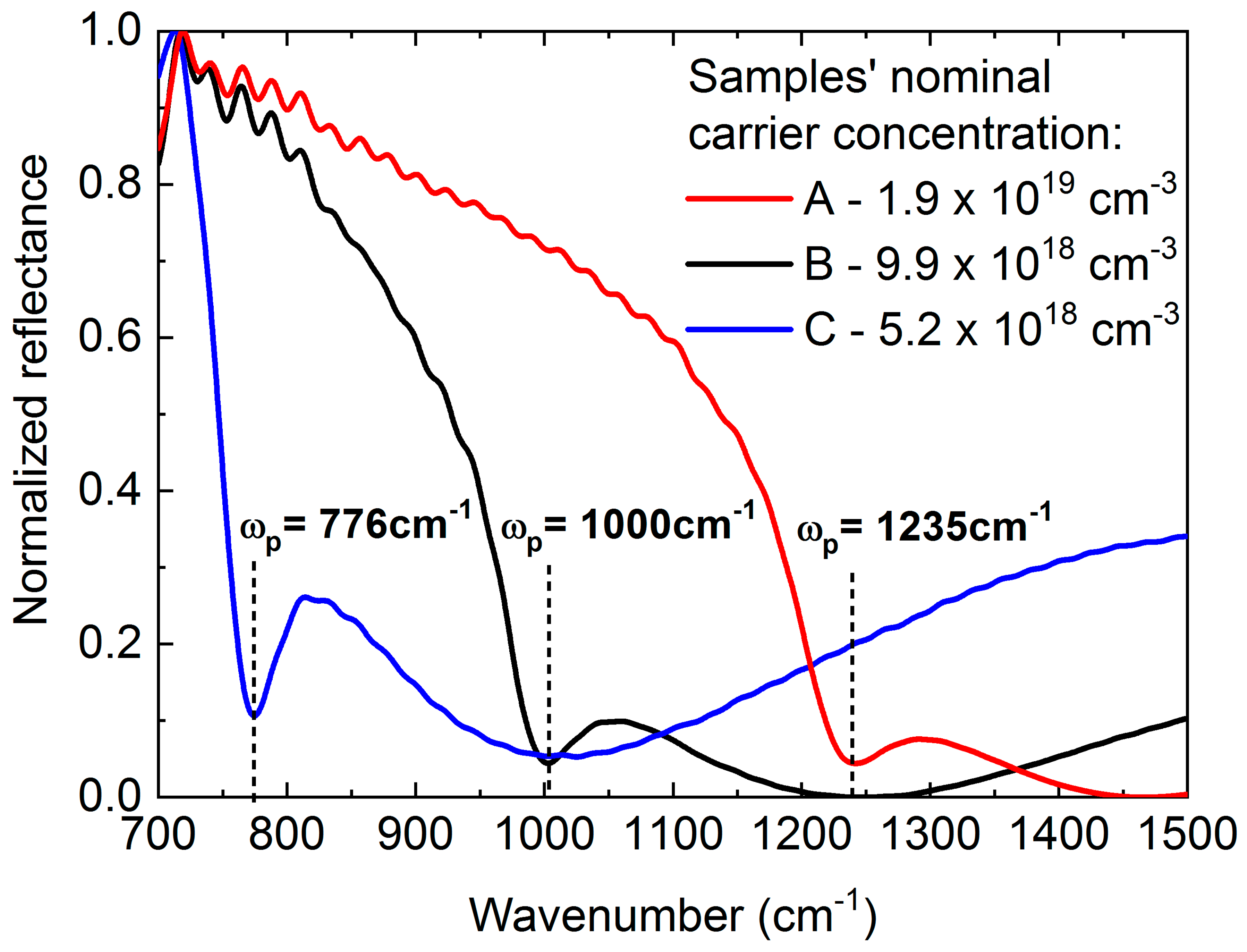
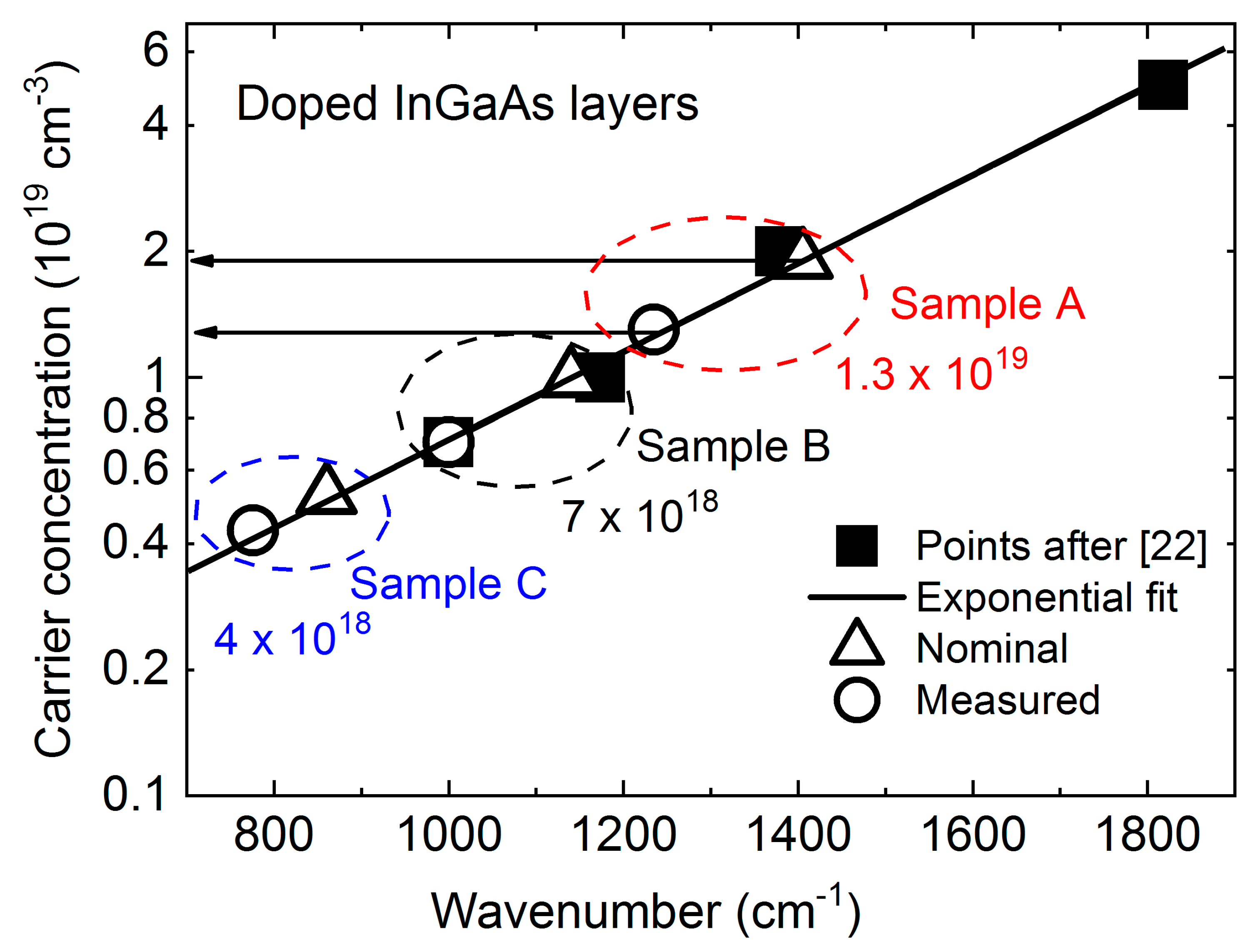
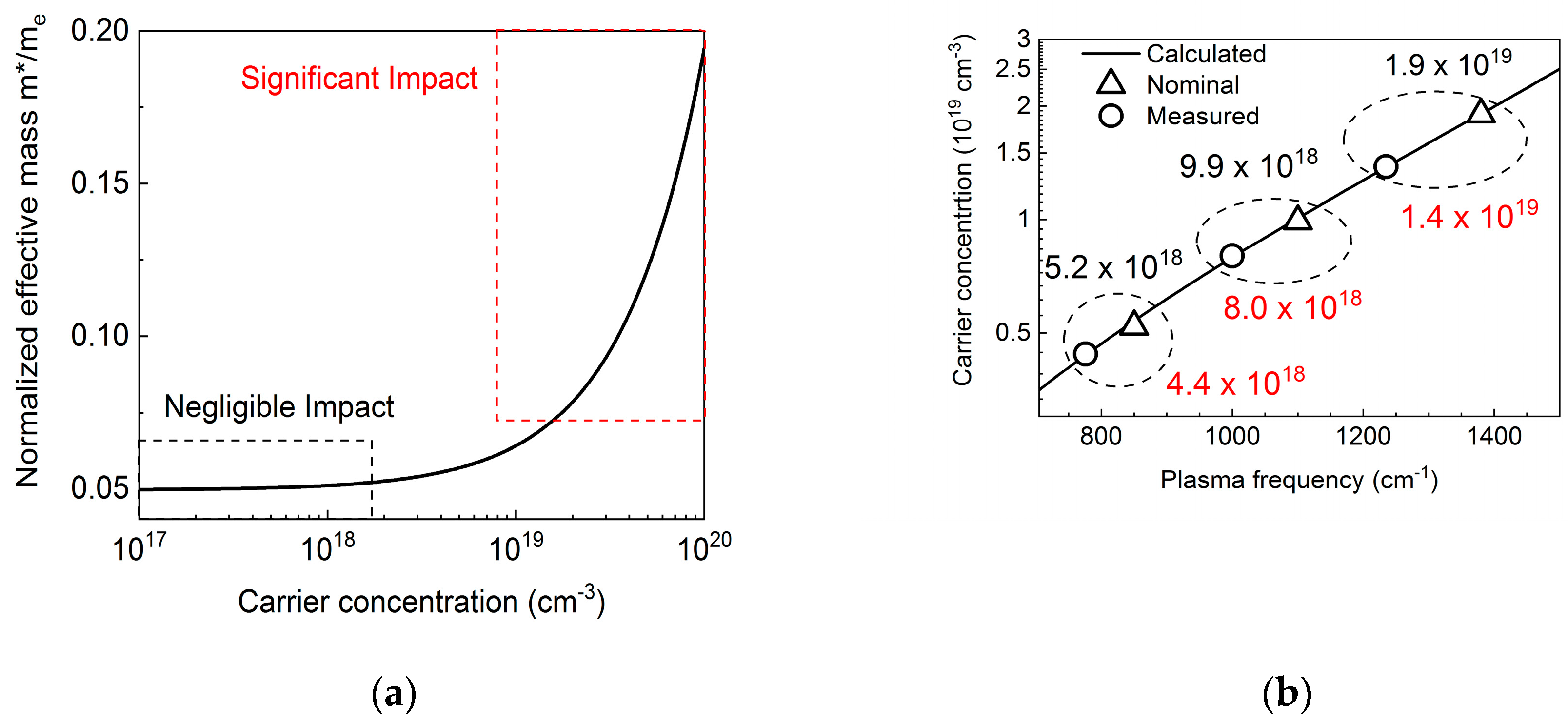
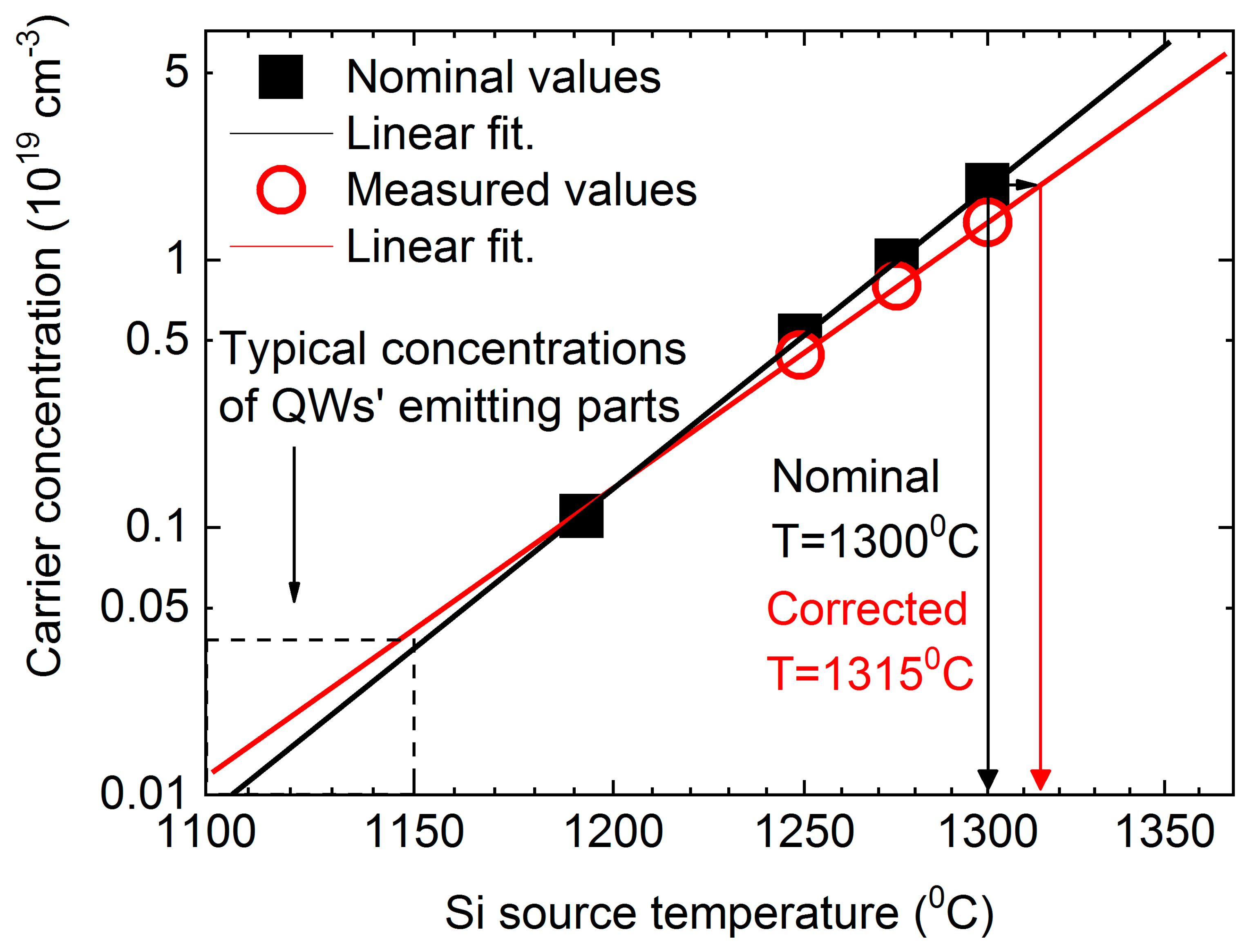
| Sample | Hall-Measured Carrier Concentration (cm−3) | Si-Source Nominal Temperature (°C) |
|---|---|---|
| (A) C766 | 1.9 × 1019 | 1300 |
| (B) C764 | 9.9 × 1018 | 1275 |
| (C) C763 | 5.2 × 1018 | 1250 |
| (D) C759 | 1.1 × 1018 | 1190 |
| Sample | Nominal Carrier Concentration | First Approach | Second Approach |
|---|---|---|---|
| (A) C766 | 1.9 × 1019 | 1.3 × 1019 | 1.38 × 1019 |
| (B) C764 | 9.9 × 1018 | 7.0 × 1018 | 8.0 × 1018 |
| (C) C763 | 5.2 × 1018 | 4.0 × 1018 | 4.4 × 1018 |
| (D) C759 | 1.1 × 1018 | N/A | N/A |
© 2020 by the authors. Licensee MDPI, Basel, Switzerland. This article is an open access article distributed under the terms and conditions of the Creative Commons Attribution (CC BY) license (http://creativecommons.org/licenses/by/4.0/).
Share and Cite
Kurka, M.; Rygała, M.; Sęk, G.; Gutowski, P.; Pierściński, K.; Motyka, M. Contactless Measurements of Carrier Concentrations in InGaAs Layers for Utilizing in InP-Based Quantum Cascade Lasers by Employing Optical Spectroscopy. Materials 2020, 13, 3109. https://doi.org/10.3390/ma13143109
Kurka M, Rygała M, Sęk G, Gutowski P, Pierściński K, Motyka M. Contactless Measurements of Carrier Concentrations in InGaAs Layers for Utilizing in InP-Based Quantum Cascade Lasers by Employing Optical Spectroscopy. Materials. 2020; 13(14):3109. https://doi.org/10.3390/ma13143109
Chicago/Turabian StyleKurka, Marcin, Michał Rygała, Grzegorz Sęk, Piotr Gutowski, Kamil Pierściński, and Marcin Motyka. 2020. "Contactless Measurements of Carrier Concentrations in InGaAs Layers for Utilizing in InP-Based Quantum Cascade Lasers by Employing Optical Spectroscopy" Materials 13, no. 14: 3109. https://doi.org/10.3390/ma13143109
APA StyleKurka, M., Rygała, M., Sęk, G., Gutowski, P., Pierściński, K., & Motyka, M. (2020). Contactless Measurements of Carrier Concentrations in InGaAs Layers for Utilizing in InP-Based Quantum Cascade Lasers by Employing Optical Spectroscopy. Materials, 13(14), 3109. https://doi.org/10.3390/ma13143109







